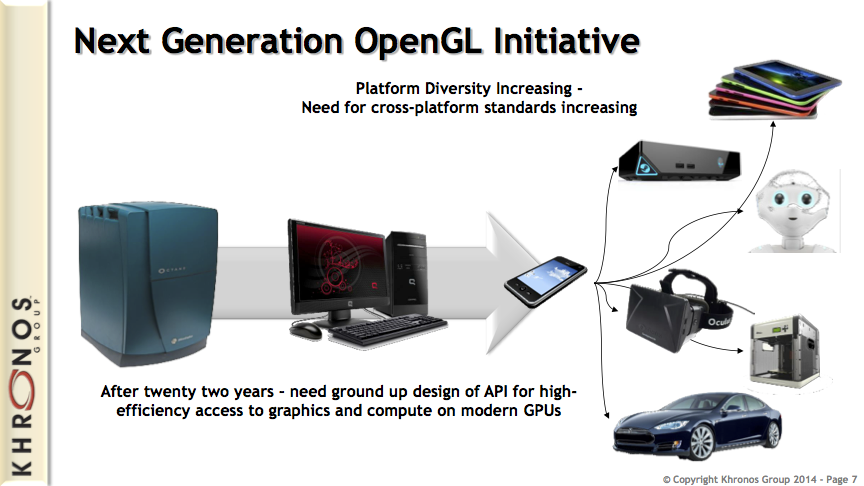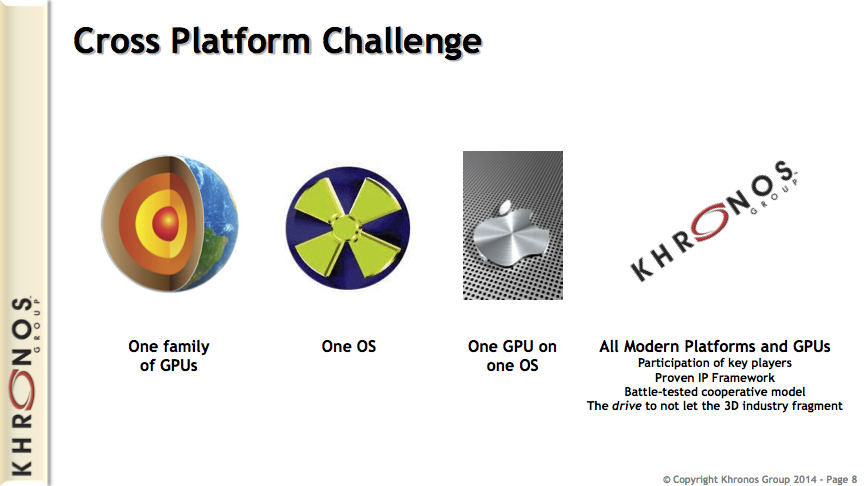Valve is investing in OpenGL to hedge themselves against Microsoft. Some well-known developers have written about the deficiencies in the API. A few competing, proprietary APIs have popped up. In an effort to remain competitive, Khronos announces glnext: a ground-up rethinking of the OpenGL and OpenGL ES APIs. This post will look at developments in the OpenGL ecosystem over the last couple of years.
Valve
In July of 2012, Valve announced that they were developing a Linux version of Steam. In late 2013, Valve further announced their new Linux-based operating system SteamOS.
On Linux, OpenGL is the only API available for hardware accellerated 3D. Therefore, an investment in Linux necessarily means an investment in OpenGL. While porting Left 4 Dead 2 to Linux, Valve stated: “We’ve been working with Nvidia, AMD, and Intel to improve graphic driver performance on Linux”.
On top of that, Valve have developed and open-sourced a couple of OpenGL tools. ToGL is a Direct3D to OpenGL translation layer, including a HLSL to GLSL converter. Vogl provides some sorely-needed debugging facilities. These two projects were dumped onto github in a somewhat hasty manner. Nevertheless, these are welcome additions, considering the historical lack of tooling in the OpenGL ecosystem.
On top of that, Valve are also funding some development of Mesa, an open-source implementation of OpenGL.
This is all great news for OpenGL in general. Everyone benefits from such a large and influential company pushing for better performance, tooling, and stability. As long a Valve’s long-term strategy continues to involves Linux, they will be a boon to OpenGL.
Criticism
It wasn’t all roses from Valve, though. Rich Geldreich, who developed Vogl as a Valve employee, started a storm with his blog post: Things that drive me nuts about OpenGL. His post is a laundry list of OpenGL criticisms, compared to other modern graphics APIs. It set off a cascade of reactions. The pains that Rich identified resonated with a lot of OpenGL developers, although some dismissed them with a big middle finger.
In June of 2014, Rich wrote:
BTW - I’m no longer at Valve or working on vogl. And no, I’m not being paid by, nor do I know anyone still at Apple, lol.
To me, Vogl represented real progress in an ecosystem that was maybe a bit stagnant, so it’s a little disheartening to see Rich leaving so soon.
Mantle, Metal, and DirectX 12
In September of 2013, AMD announced a new, low-level graphics API called Mantle, designed to be an alternative to OpenGL and Direct3D. The idea with Mantle was to allow direct access to AMD hardware with an absolute minimum of driver overhead, something that OpenGL and DirectX didn’t really offer at the time. AMD boasted that Mantle offered large performance gains compared to “other APIs.” A few large names, such as Crytek and DICE, jumped on board, and implemented Mantle in their game engines. AMD also claimed that Mantle would eventually be an open standard, but currently, a year after its announcement, we are still yet to see any progress towards this.
A few months later, Microsoft announces DirectX 12, which sounds a lot like Mantle. The main difference from DX11 is the significantly reduced driver overhead, and more direct access to hardware.
Then, in July of 2014, Apple follows suit and releases its own low-level graphics API called Metal. Prior to Metal, OpenGL ES was the only option for iOS devices. In fact, Apple’s use of OpenGL ES in their iPhones was one of the major factors contributing to the OpenGL renaissance that we see today. And now, having been such an ally, Apple turns around and creates a competitor. Some speculate that Apple dislikes the cross-platform nature of OpenGL, and would prefer to lock developers into the iOS ecosystem. Others say that Metal is just a better API, and OpenGL was ripe for replacement.
With three cutting-edge competitors announced within a year of eachother, while OpenGL still carries 20 years of baggage along with it, it’s not unreasonable to beleive that OpenGL may be fighting for its survival over the next few years.
Joshua Barczak explains this new taste for low-level graphics APIs in his excellent blog post: The Race to the Metal.
AZDO
At GDC 2014, back in March, developers from AMD, Nvidia, and Intel came together to give a presentation called Approaching Zero Driver Overhead (AZDO). The premise of the presentation is that OpenGL 4.4 does actually provide low-level functionality, sort of like Mantle, if you know where to find it. This presentation is a fantastic overview of the cutting-edge features of OpenGL.
glnext
Last month, in a presentation at SIGGRAPH 2014, Khronos announced the “Next Generation OpenGL Initiative” (which I’m going to refer to as “glnext” here).

Here are a few excerpts from the presentation, relating to glnext:
- After twenty two years – need ground up design of API for high-efficiency access to graphics and compute on modern GPUs.
- Incremental change is not enough. GL has a good track record of adaptive evolution… but structural problems can’t be fixed by accretion.
- Who’s on board: Valve, Apple, AMD, Intel, Nvidia, and others.
- Fast-paced work on detailed proposals and designs are already underway
- NOT your father’s multi-year design-by-committee process
- Goals:
- Clean, modern architecture
- Greatly reduced CPU overhead
- Multi-thread / multicore-friendly
- Improved reliability and consistency between implementations
- Unify OpenGL and OpenGL ES
In the presentation, Khronos directly mentions Rich Gelrich’s criticisms under the heading “OpenGL needs to change”, and I think that this is a great indication that we will see some real improvements baked into glnext. John McDonald from Valve states that “glnext is shaping up to be amazing.”
Richard Huddy says that AMD is giving Khronos full access to Mantle, and will impose no restrictions or licensing fees if glnext takes ideas from the architecture of Mantle.
OpenGL 4.5 And The Current Ecosystem
But wait, there’s more! While we wait for glnext, OpenGL development rolls on. In the same SIGGRAPH 2014 presentation, Khronos announced OpenGL 4.5, and gave an overview of the whole OpenGL ecosystem.
Among other things, 4.5 finally, finally, brings Direct State Access (DSA) into core. It’s my personal opinion that a lot of the perceived cruft in OpenGL stems from being forced to constantly manipulate the state machine, which is basically a huge collection of mutable global variables, and DSA alleviates a lot of this pain. In addition to the developer-frendliness that DSA brings, it also enables a set of possible performance improvements.

In tooling news, Vogl development continues, and it now runs on Windows. AMD, Nvidia, and Intel are all improving performance profiling through their own proprietary tools. The GLSL reference validator is getting better, helping to fix headaches around cross-platform shader compilation.
Conformance testing is also being ramped up. One of OpenGL’s uglier problems is driver conformance, but it appears that this situation is improving.
Conclusion
The AZDO presentation showed that OpenGL is still competitive when compared to Mantle, Metal, and DirectX 12. Also, glnext is poised to clean up a lot of the crusty parts, and unify OpenGL and OpenGL ES into a single, modern, ultra-cross-platform API.
I think this slide from the SIGGRAPH presentation sums up why OpenGL is, and will remain to be, relevant:

Mantle only currently works with certain AMD hardware on Windows. Metal only works on iOS. DirectX 12 will only work on Windows. OpenGL is the only truly cross-platform option. It’s the only option that works on all hardware across Windows, OSX, Linux, Android and iOS. It’s the only option on Linux, so if Valve’s vision for Linux comes to fruition, OpenGL will be more relevant than ever.
I’m optimistic about the future of OpenGL/glnext. We just have to wait and see if the vendors play nice together.
